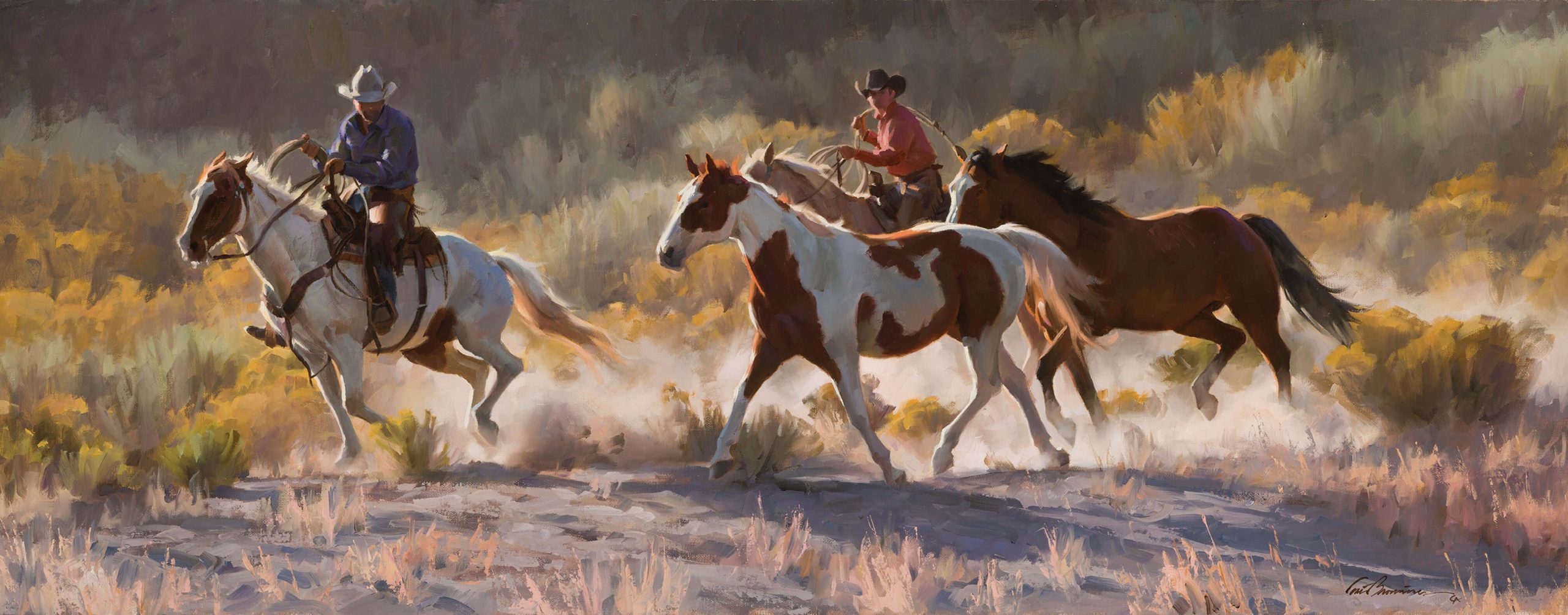
04 Jan The Art of Simplicity
If there were one word to define Tom Browning’s life and artistic career, it would be simplicity. Simplicity in the rural Eastern Oregon lifestyle he was born into. Simplicity in purpose and direction from early on in his life. And simplicity in his painting style.
“The one thing that I got from everything I’ve done over the years and what I’m still trying to express is simplicity,” says Browning. “The more directly and simply a painting is done, the more I appreciate it.”
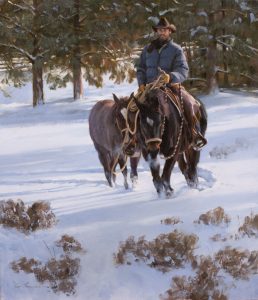
Winter Coats | Oil on Canvas | 28 x 24 inches
Browning’s path to becoming an artist had an early start. Growing up in Eastern Oregon, his fourth-grade teacher, Mrs. Wilcox, saw his talent and one day announced to the entire grade that he was “the artist of the class.” The moniker stuck.
Early on, Browning looked toward living artists for direction to help hone this style and way of painting, including influential painters Ned Jacob, William Reese, and James Reynolds. “They were among those from whom I sought guidance and instruction, all becoming willing and helpful mentors,” says Browning. “They each showed me where they got their inspiration, and this opened yet another door into a world of painters that I could study and try to pick up new techniques.”
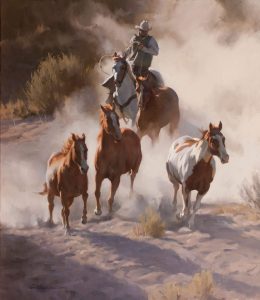
Downhill Run | Oil on Canvas | 34 x 30 inches
Discovering the work of Charlie Russell and illustrators from the Golden Era also propelled his artistic journey. “[Russell’s] work was really a catalyst for me and sent my career in the direction that I have maintained since I began painting professionally,” says Browning. “I had always been interested in Western art, but the energy that I felt after seeing his work set a whole new standard for me. During my formative years, I started studying the styles and techniques of illustrators from the Golden Era, particularly artists such as Haddon Sundblom and Saul Tepper. I got my hands on stacks and stacks of old magazines from the early 1900s that were filled with work I had never seen before. It further fueled the flame inside of me and expanded my interests, ideas, and ambitions.”
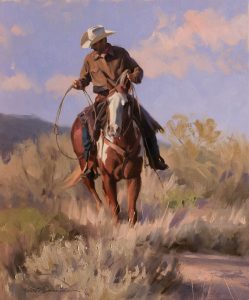
Barry | Oil on Canvas | 18 x 15 inches
While most fine artists start in illustration or design and gradually become full-time artists, Browning has worked solely in fine art his entire career. “It’s pretty much been fine art from the beginning,” says Browning. “There were a lot of circumstances early on that led to doors being open for me. I’ve always considered myself very lucky. You can’t make how I started into a formula; it just happened. I started with watercolors of cowboys and horses, got into scratchboard, and did tons of those, mainly wildlife and Western — ‘fur and feathers,’ I used to say.”
After graduating from the University of Oregon with an art degree, Browning connected with a friend who owned a gallery in Portland, Oregon. “He was from Montana but was asked to start a Western gallery in Portland,” says Browning. “This was in the early ’70s, and it was called Trails End Gallery. He wanted to show my work, and I was doing scratchboard pieces at the time. And he started selling everything I could produce.”
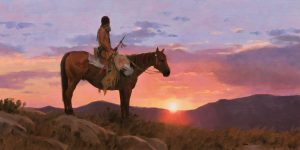
When the Hills are Kissed by the Sun | Oil on Canvas | 14 x 24 inches
Today, Browning is represented by InSight Gallery in Fredericksburg, Texas; Legacy Gallery in Scottsdale, Arizona; Mockingbird Gallery in Bend, Oregon; and Wilcox Gallery in Jackson, Wyoming.
“Tom brings some of the most compelling and beautiful depictions of the West to life on his canvases, showing us his mastery of motion, mood, and light while telling stories filled with tradition and honor,” says Jim Peterson, owner of Mockingbird Gallery. “He achieves this with a quiet and humble approach that draws admiration and respect from all those in his circle.”
Brad Richardson, the owner of Legacy Gallery, sees collectors continually turning to Browning’s work for its quality and versatility. “We’ve had the pleasure of representing Tom for the past decade and even though he is most noted for his dusty action cowboy pieces, he is an extremely diverse artist and paints a variety of subject matter, from prayer family scenes to Santa Claus,” says Richardson. “It seems like there is nothing he can’t paint and paint well.”
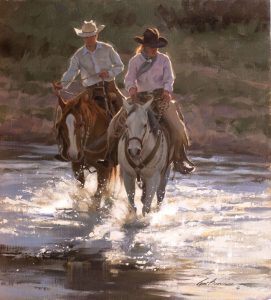
The Long Way Home | Oil on Canvas | 20 x 18 inches
Over the course of his decades-long career, Browning recalls two defining moments in 2009: the first was winning the Prix De West Purchase Award for his painting Dawn of a New Day at the National Cowboy & Western Heritage Museum and the second was joining the Cowboy Artists of America (CAA).
“I had won awards before, but [the Prix de West Purchase Award] was the first on a major and national level. It definitely took things in a new direction, and I became a little more focused on what I was doing. It helped me hone my subject matter and make it a little more unified. And that’s when I really started to focus on telling the story of the West,” Browning says.
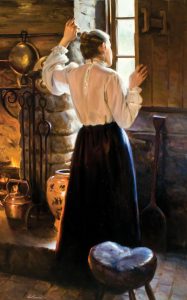
Dawn of a New Day | Oil on Canvas | 24 x 16 inches
While Western art collectors had been following Browning’s career, these national shows and awards increased his visibility in the minds of many. Billy and Ann Mitchell of Midland, Texas, attended their first CAA show in 2014 and were immediately drawn to Browning’s painting Cut Off. “We were amazed at the brilliance of his art, the smoothness of the strokes, and the definition of the land’s contours, horses, and horsemen,” says Billy Mitchell. “He is able to portray the dust at a horse’s feet as fog lays on the leaves of a fall day. Tom’s artistic style is uniquely identifiable among others of his craft, surpassed only by the substance of the character of he and his wife. Just exceptional.”
“Tom is highly respected by his fellow artists and collectors alike,” says collector Gary Kinslow of Oklahoma City. “We have been fortunate enough to collect several of Tom’s masterpieces over the years, including two of his Santa Claus Christmas paintings. We have also been blessed to collect art from several of the leading Western artists today, and there’s not a single painting that we love more than Browning’s On the Fence.”
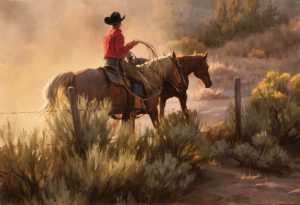
On the Fence | Oil on Canvas | 24 x 36 inches
“As I continue on my journey my goal is still the same as before, ‘get better at what I do,’” says Browning. “And luckily, I hear from patrons, other artists, and friends that my work is still getting better and better. That in itself is inspiring. It has been quite the journey since I began in 1972, but I’m happy and satisfied with how things are continuing to progress and evolve. In other words, I’m still excited about what I’m doing.”
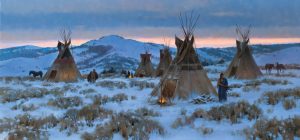
Daybreak | Oil on Canvas | 16 x 36 inches
Browning was recently granted emeritus status by the CAA and this fits perfectly into his plan of slowing down. “It seems that slowing down my schedule seems to go hand in hand with the ‘slowing down’ of each painting that I do now,” says Browning. “I noticed every painting was taking longer for some reason, and I figured out I was taking more care and spending more time on each piece. It wasn’t really intentional, but it just kind of happened naturally as I continued my perpetual goal of making each painting better than the last. Just because something in my work looks like it was done with one stroke doesn’t mean I didn’t attempt that stroke two or three times before getting it right.”






No Comments